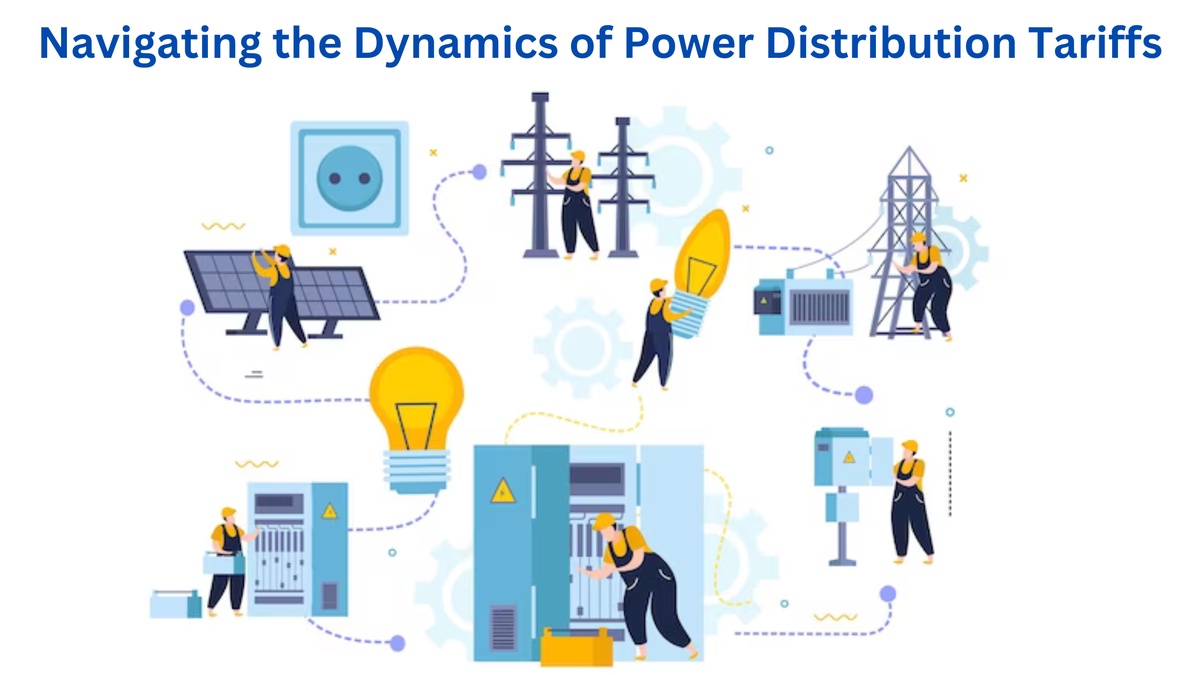Introduction:
Power distribution tariffs play a crucial role in shaping the energy landscape, influencing consumer behavior, and driving the sustainability of the power sector. In this blog, we delve into the intricacies of power distribution tariffs, exploring their significance, structure, and impact on both consumers and the broader energy ecosystem.
Understanding Power Distribution Tariffs:
Foundation of Electricity Pricing: Power distribution tariffs form the bedrock of electricity pricing, representing the costs associated with generating, transmitting, and distributing electricity to end-users. These tariffs encompass various components, including generation costs, network charges, and regulatory fees.
Tariff Structure and Components: Power distribution tariffs typically consist of fixed and variable components. The fixed component covers infrastructure costs, such as maintaining power lines and substations, while the variable component is based on the actual consumption of electricity. Time-of-use tariffs and demand-based tariffs are examples of innovative structures designed to optimize energy consumption and grid management.
Residential vs. Industrial Tariffs: Tariffs vary based on consumer categories. Residential tariffs are often designed to be more predictable and stable, providing households with a consistent pricing structure. In contrast, industrial tariffs may have more complex structures, with demand charges and time-based pricing to encourage energy efficiency among large consumers.
Impact on Consumers:
Affordability and Accessibility: The affordability of electricity is a critical factor for consumers. Power distribution tariffs directly influence the cost of electricity for households and businesses, impacting their overall expenditure. Governments and regulatory bodies aim to strike a balance between affordability and ensuring a sustainable revenue stream for power utilities.
Energy Conservation and Efficiency: Dynamic tariff structures, such as time-of-use pricing, incentivize consumers to shift their energy usage to off-peak hours when electricity demand is lower. This encourages energy conservation and contributes to the overall efficiency of the power grid by reducing the need for additional infrastructure to meet peak demand.
Renewable Energy Adoption: Some tariff structures offer incentives for renewable energy adoption. Feed-in tariffs, for example, provide compensation to individuals or businesses that generate surplus renewable energy and feed it back into the grid. Such incentives play a vital role in promoting the transition to cleaner and more sustainable energy sources.
Regulatory Framework:
Government Policies and Regulation: The regulatory framework governing power distribution tariffs is often set by government agencies or regulatory bodies. These entities establish guidelines for tariff determination, taking into account factors like inflation, infrastructure investment, and the need for utilities to maintain financial viability.
Transparent Tariff Setting: Transparent and predictable tariff-setting processes are essential for fostering trust among consumers and industry stakeholders. Regulatory bodies strive to engage in open consultations, ensuring that tariff decisions consider the interests of both consumers and power providers.
Balancing Economic Viability: Achieving a balance between the economic viability of power utilities and consumer interests is a constant challenge for regulators. Striking this equilibrium ensures a sustainable power sector, capable of meeting the growing demand for electricity while safeguarding the rights and affordability of consumers.
Innovations in Tariff Structures:
Smart Grid Technologies: The integration of smart grid technologies enables more sophisticated tariff structures. Smart meters, for instance, facilitate real-time monitoring of electricity consumption, allowing for dynamic pricing models that align with the actual demand on the grid.
Demand Response Programs: Demand response programs empower consumers to actively manage their electricity consumption in response to price signals. Through these programs, consumers can reduce or shift their usage during peak demand periods, contributing to grid stability and earning incentives in the process.
Blockchain and Decentralized Energy Markets: Emerging technologies like blockchain offer the potential to create decentralized energy markets. Through blockchain-based platforms, consumers and producers can directly engage in peer-to-peer energy transactions, bypassing traditional utility structures and potentially leading to more competitive and transparent tariff systems.
Global Perspectives on Power Distribution Tariffs:
Regional Disparities: Power distribution tariffs vary significantly from region to region due to differences in energy infrastructure, resource availability, and government policies. While some regions may prioritize affordability, others may focus on incentivizing renewable energy adoption or promoting energy efficiency.
Electrification Initiatives: In some parts of the world, governments are implementing electrification initiatives to improve access to electricity in underserved areas. Tariff structures in these regions aim to balance the need for revenue generation with the goal of ensuring affordable and reliable electricity for all.
Incentives for Energy Transition: Many countries are revising their tariff structures to align with broader energy transition goals. Incentives for transitioning to renewable energy, coupled with penalties for high carbon intensity, are becoming integral parts of tariff structures, encouraging a shift towards more sustainable energy practices.
Future Trends and Considerations:
Digitalization and Data Analytics: The increasing digitalization of the power sector, coupled with data analytics, will play a pivotal role in shaping future tariff structures. These technologies enable more granular and responsive pricing models, enhancing overall grid efficiency.
Integration of Energy Storage: As energy storage technologies advance, their integration into the power grid will influence tariff structures. Storage solutions can mitigate the impact of intermittent renewable sources, contributing to grid stability and potentially affecting peak demand pricing.
Consumer Empowerment: Future tariff structures are likely to focus on empowering consumers with more choices and control over their energy consumption. Technologies such as home energy management systems and blockchain-based platforms may give consumers greater autonomy in managing their energy costs.
Conclusion:
Power distribution tariffs serve as a linchpin in the energy ecosystem, influencing consumption patterns, driving investments, and shaping the trajectory of the power sector. As we navigate a future characterized by increasing electrification, renewable energy integration, and technological innovations, the dynamics of power distribution tariffs will continue to evolve. Striking a delicate balance between economic viability, sustainability, and consumer interests, the future of power distribution tariffs holds the promise of fostering a resilient, efficient, and inclusive energy landscape.
More market research, advisory consulting services to discover
At Eninrac, we offer a wide range of, advisory consulting solutions, from We put ‘search’ in research to help expand your business with ease. Discover all the possibilities now.


No comments yet